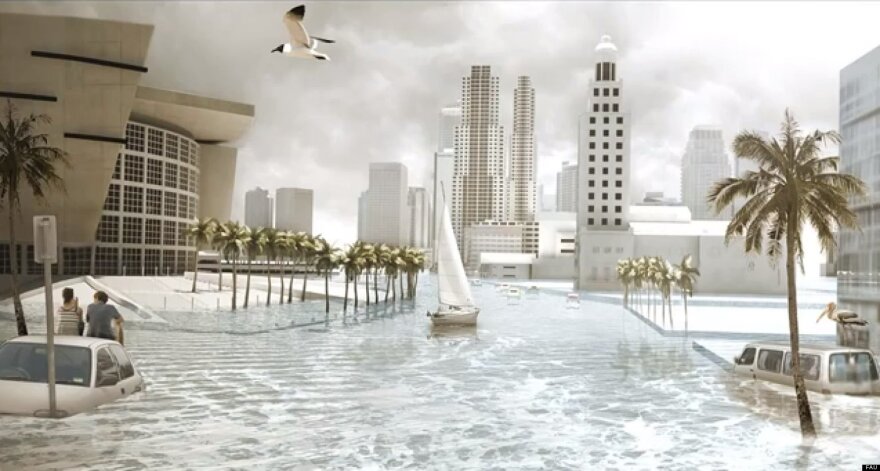Miami as the modern Atlantis has a strangely tragic and romantic appeal.
Officially founded in 1896 (though there were settlers for some 75 years before that), and if a Rolling Stone article due to hit newsstands on July 4 is correct, Miami and the rest of coastal South Florida is looking at a very succinct timeline of existence.
To this day, we have spent our short time in the swamp molding the landscape to sustain life. And despite the predictions made by contributing editor Jeff Goodell in the alarming article “Goodbye Miami,” we all live here, and have to reckon with whatever tragedies Mother Nature hurls our way.
So if the predictions come true, we will have been part of a strange and punctuated narrative, one bursting with excitement and yet often misunderstood.
But the reality of that story is horrifying. Many would flee, and many more would be reduced to nothing. Here's an excerpt:

“Sea-level rise is not a hypothetical disaster. It is a physical fact of life on a warming planet, the basic dynamics of which even a child can understand: Heat melts ice. Since the 1920s, the global average sea level has risen about nine inches, mostly from the thermal expansion of the ocean water. But thanks to our 200-year-long fossil-fuel binge, the great ice sheets in Greenland and Antarctica are starting to melt rapidly now, causing the rate of sea-level rise to grow exponentially. The latest research, including an assessment by the National Oceanic and Atmospheric Administration, suggests that sea level could rise more than six feet by the end of the century. James Hansen, the godfather of global-warming science, has argued that it could increase as high as 16 feet by then... "With six feet of sea-level rise, South Florida is toast," says Tom Gustafson, a former Florida Speaker of the House and a climate-change-policy advocate. Even if we cut carbon pollution overnight, it won't save us. Ohio State glaciologist Jason Box has said he believes we already have 70 feet of sea-level rise baked into the system.”
The air of inevitability with which the article was received when it was released online is telling. The Internet produced some shrugs, some I-told-you-so’s, but mostly a general consensus that, yes, we live surrounded by water and one day might have to reckon with that truth in a harsh and unpredictable fashion. It seems that if this is the case, we must begin to prepare.
Part of the conversation is politicized and has a tendency to divide along party lines. Free market capitalists think that scientific research that hopes to curb carbon emissions is invasive and unwarranted and liberal proponents of climate change sometimes speak to science they don’t properly understand.
Goodell cites a great many experts, whose opinions you can choose to ignore or accumulate anxiety over depending on your own take. Whatever your stance on sea-level rise may actually be, you cannot deny that the world has shown us five Ice Ages. Drastic worldwide climate change happens and borders are often redefined after them.
WLRN has been on the forefront of sea-level rise reporting in South Florida for some time now. It seems that many of the other news institutions choose to only superficially cover what is becoming more and more obvious. Editors have made a conscious decision to cover all of the ins and outs, as well as professional and expert opinions on what will be a constantly developing and major story moving forward.
But while coverage is important, real preventative action needs to be taken. As Angela Colbert, content curator for the Miami Science Museum and a Ph.D. candidate in Meteorology and Physical Oceanography states, “Miami is at a point where it needs to start making decisions and plans for the future. It’s going to change. And the people working at it want to keep as much of ‘Miami’ as they can.”
Those people are actually the South Florida Regional Climate Change Compact, a partnership between the four counties of Miami-Dade, Broward, Palm Beach and Monroe that is focused on enacting real change on these issues. Their next meeting is in November.
There are smart people working on these issues, but as the article states, some of the problems are very large. Among those that Goodell brings up is the future of potable water, the fate of the Turkey Point Nuclear Station, as well as the porous nature of the limestone underneath the city, flatness of our land, and the very real stumbling block of disinterested politicians.
Perhaps the Rolling Stone article can spark some real change, but we have to collectively decide to make a stance and work towards preserving the place we have all built in some tangible way. Handwringing as our legs submerge under the Atlantic would be symbolic, but useless.






